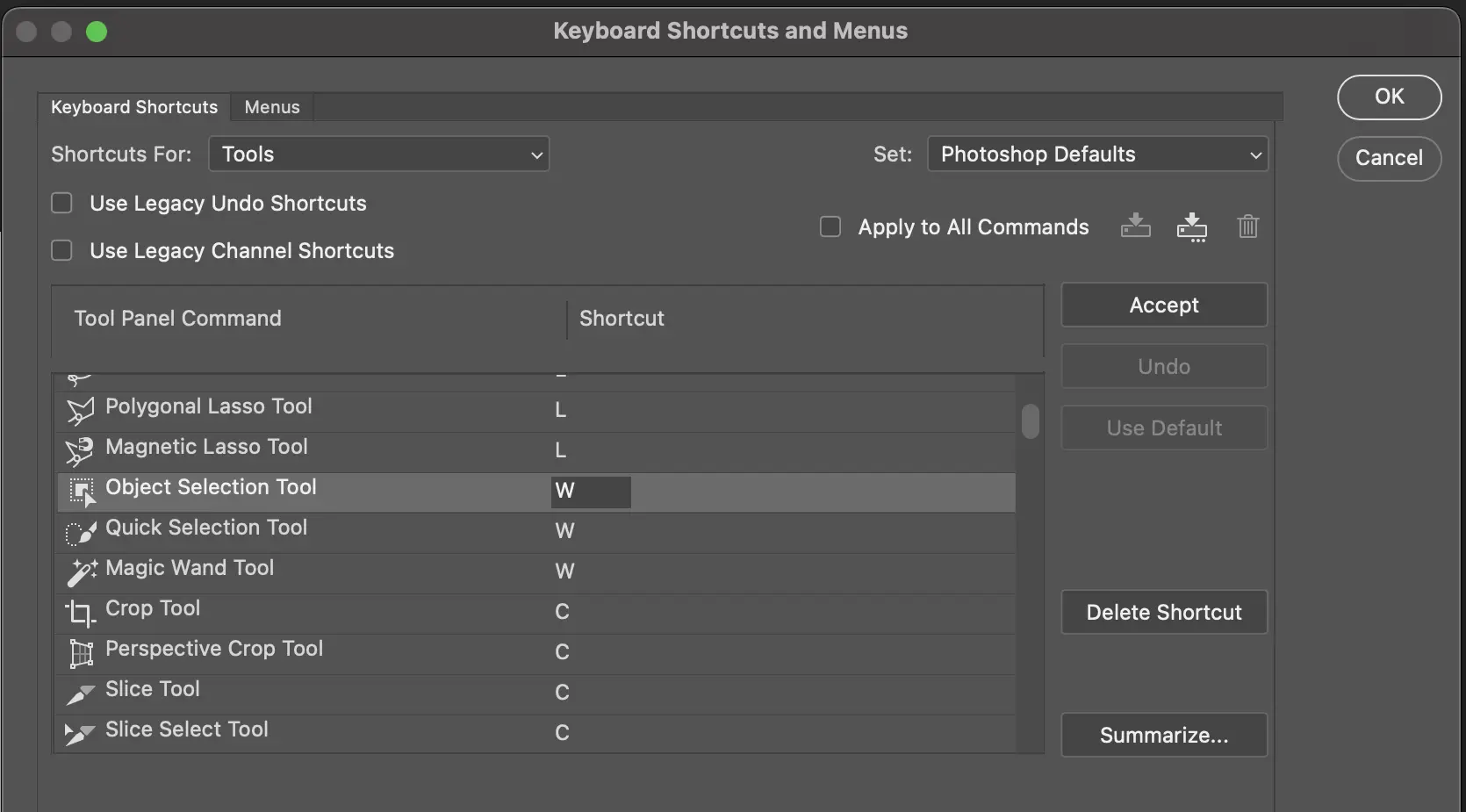
Mastering the object selection tool in Photoshop is a vital skill every aspiring designer and editor should have.This versatile instrument empowers you to intuitively isolate elements from an image, altering details with precision.
Whether removing background or dabbling with color adjustments, this handy tool gives excellent results compared to more crude instruments like a lasso or wand.
E-commerce stores could especially benefit from mastering this aspect either in Photoshop or Lightroom, as producing appealing product images often necessitates making individual selections.
In our comprehensive guide below, we gradually break down each part so that you understand its functionality and know when and why to use what during your edits.
Table of Contents
Why Use the Object Selection Tool?
Navigating through Photoshop’s myriad features can be daunting, but this tool implifies a crucial aspect of photo editing: isolating and modifying elements within an image.
Essential part of a photo editor’s arsenal, allowing for quick and precise alterations without the need for meticulous manual work.
The Object Selection Tool is a relatively recent addition to Photoshop’s suite of features. It offers users a streamlined approach to selecting objects within an image.
It utilizes Adobe’s Sensei AI technology to detect and select objects or parts of objects with a simple click or marquee drag.
- To activate the tool, locate it in the toolbar or use the keyboard shortcut 'W.'
- Once selected, choose a rectangular or lasso mode to outline the area containing the object.
- Photoshop then automatically analyzes the contents and snaps the selection to the boundaries of the object.
Benefits of Using this Tool
By automating the selection process, it minimizes the time spent on one of Photoshop’s most basic yet time-consuming tasks.
- It reduces manual labor by automatically detecting object boundaries.
- Offers a high degree of precision, which is particularly useful when working with complex subjects.
- Enhances productivity, allowing editors to focus on creative aspects of photo manipulation.
When to Use Object Selection Tool

This tool shines in scenarios where quick selection is paramount.
- Ideal for images with clear contrast and well-defined objects.
- Use it when working with layers to quickly isolate and edit specific elements.
- It's also useful for creating masks or selecting objects for color correction.
For further insights on selection tools, consider exploring Selection Tools in Photoshop.
This tool compares the Object Selection Tool with other available options, providing a more rounded understanding of when and how to use each tool effectively.
How to Use Object Selection Tool
Beyond the basics, the Object Selection Tool can be used in conjunction with other Photoshop features to refine selections and achieve professional results.
- After making an initial selection, use the 'Select and Mask' workspace to refine the selection edges.
- Combine with the 'Content-Aware Fill' feature to remove unwanted objects seamlessly, which can be further explored through the Content-Aware Fill in Photoshop tutorial.
- Integrate with layer masks to non-destructively hide or reveal parts of an image.
Getting Started
Navigating Adobe Photoshop’s features can be daunting for newcomers and seasoned users alike.
The Object Selection tool, in particular, presents a world of possibilities for swiftly isolating and manipulating elements within a graphic.
This section will delve into practical steps and tips for harnessing the full potential of this powerful feature.
Accessing Object Selection Tool
The gateway to utilizing the Object Selection tool is straightforward.
Initiate by locating the tool within the main toolbar, typically symbolized by a rectangular marquee with a dotted outline.
If it’s not immediately visible, it may be nested with the Quick Selection or Magic Wand tools. Simply click and hold on either of these icons to reveal the Object Selection tool.
To activate the tool, you can either click on its icon or use the keyboard shortcut ‘W,’ which quickly toggles between the Object Selection, Quick Selection, and Magic Wand tools.
Once selected, the options bar at the top of the workspace presents a suite of settings to refine your selection process.
These include the Mode, which allows you to decide between creating a new selection, adding to an existing one, or subtracting from it.
Basic Steps to Select Objects
With the Object Selection tool active, the basic steps to select an object within your photo are as follows:
- Choose your desired selection mode from the options bar.
- Click and drag around the object you wish to select. Photoshop will automatically analyze the contents and snap the selection to the object's boundaries.
- If the initial selection isn't perfect, use the 'Add to selection' or 'Subtract from selection' options to refine it by clicking and dragging over the areas you want to include or exclude.
- For complex objects, consider using the Lasso or Polygonal Lasso tools to draw around the intricate edges manually.
Tips for Effective Selection
Maximizing the efficiency of the Object Selection tool involves a few key strategies:
- Utilize the Select Subject button in the options bar for an instant automatic selection of the primary subject in your image.
- When dealing with objects against a contrasting background, increase the 'Object Finder' functionality to help Photoshop better understand what you're trying to select.
- Apply the 'Enhance Edge' feature found in the 'Select and Mask' workspace to fine-tune the edges of your selection for a cleaner, more professional result.
Remember to regularly save your progress, especially after achieving a precise selection, to avoid any loss of work due to unforeseen circumstances.
Incorporating these techniques into your workflow can markedly improve your selection accuracy and speed, allowing for a smoother editing process in your creative endeavors.
Pro Tip: Learn to utilize Photoshop’s smart select feature for an even better workflow!
Advanced Techniques in Object Selection

Transitioning from the basics, let’s dive into the more sophisticated methods that can elevate your work in Photoshop.
These advanced strategies will allow you to refine your selections, integrate them with other layers, and combine tools for a more efficient workflow.
Refining Edges of Selections
To achieve a flawless cut-out, the edges of your selections need to be crisp yet natural.
Begin by using the ‘Select and Mask’ workspace, which you can access from the options bar at the top of the workspace after making an initial selection. Here’s a step-by-step approach:
- With your selection active, click on 'Select and Mask.
- Adjust the 'Smooth,' 'Feather,' and 'Contrast' sliders to refine the edge.
- Use the 'Refine Edge Brush' to paint over complex areas like hair or fur.
- Preview the changes on different backgrounds to ensure a realistic look.
- Output your refined selection to a new layer mask for further editing.
Pro Tip: Toggle the ‘View Mode’ within ‘Select and Mask’ to see your selection against various backgrounds, ensuring it looks good in all scenarios.
Using Object Selection with Layers
Layers are fundamental in Photoshop, and combining them with object selection can streamline your editing process. Here’s how to make the most of this combination:
- Create or select the layer where your object resides.
- Use the Object Selection Tool to outline the item you want to isolate.
- Once selected, right-click and choose 'Layer via Copy' to place your selection on a new layer.
- Manipulate this new layer independently, adjusting position size or applying filters.
Remember: Label your layers clearly to keep track of your selections and stay organized.
Combining Object Selection with Other Tools
The Object Selection Tool doesn’t always have to work alone. Combine it with other tools for improved precision:
- Use the 'Quick Selection' or 'Magic Wand' tools to start a rough selection.
- Switch to the Object Selection Tool to refine the selection, especially around tricky areas.
- If necessary, switch to the 'Lasso Tool' to manually adjust the selection by adding or subtracting from it.
Efficiency Hack: Hold down ‘Alt’ (Option on Mac) to subtract from your selection or ‘Shift’ to add to it without changing tools.
Troubleshooting Common Issues
Navigating the complexities of the Object Selection tool in Photoshop can sometimes lead to hiccups.
Whether it’s a selection that’s not quite right or a background that’s more challenging than expected, there are strategies to overcome these obstacles.
Let’s explore some tailored solutions to enhance your workflow and achieve the precision you desire.
Solving Selection Accuracy Problems
When accuracy is less than ideal, there are several steps you can take to improve the outcome. First, zoom in on the area you’re working with.
This allows for a closer examination and finer control. Use the ‘Quick Mask mode’ for a visual representation of your selections, and apply the ‘Pen tool’ for precision editing.
Remember to utilize the ‘Refine Edge’ feature to smooth out any rough perimeters. Here’s a step-by-step approach:
- Zoom into the problematic section of your photo.
- Switch to 'Quick Mask mode' for a clear view of the selected and unselected areas.
- With the 'Pen tool,' carefully outline the exact shape you need.
- Once your path is complete, convert it to a selection and fine-tune it with 'Refine Edge.'
- If necessary, adjust the feathering to blend the edges seamlessly.
For those quick edits where time is of the essence, master the Quick Selection tool in Photoshop.
Dealing with Complex Backgrounds
Complex backgrounds can make object isolation a challenge.
To tackle this, employ the ‘Select and Mask‘ workspace, which provides advanced settings to differentiate between similar colors and textures.
Make use of the ‘Edge Detection‘ feature to help distinguish the object from its surroundings. Additionally, the ‘Background Eraser tool‘ can be a lifesaver in such scenarios.
Follow these guidelines:
- Open the 'Select and Mask' workspace to access powerful edge refinement tools.
- Adjust the 'Edge Detection' radius to help Photoshop differentiate between the object and the background.
- Use the 'Background Eraser tool' to click and drag around the object, erasing similar pixels.
- If the background bleeds into your object, you can use the 'Clone Stamp' or 'Healing Brush' to clean it up.
Discover the fun of combining multiple images into a single composition with our steps on How to make a collage in Photoshop.
Improving Selections with Additional Tools
Sometimes, the Object Selection tool needs a helping hand. Integrating it with other tools like the ‘Lasso’ or ‘Brush’ tool can refine your selections.
The ‘Layer Masks’ feature also offers non-destructive editing options to hide or reveal parts of an image. Here’s how to combine these tools for a refined selection:
- Make your initial selection with the Object Selection tool.
- Switch to the 'Lasso tool' with the 'Shift' key to add to your selection or the 'Alt' key to subtract from it.
- Use a soft-edged 'Brush' on a 'Layer Mask' to paint in or erase sections of the object.
- Continually toggle the 'Mask' visibility to ensure your edits are precise and accurate.
Learn to change hues with precision in our tutorial about the Replace Color Tool in Photoshop.
Optimizing Workflow with the Object Selection Tool in Photoshop
Transitioning from basic functions to more nuanced techniques can significantly streamline your editing workflow in Adobe’s renowned image editing software.
This section delves into lesser-known strategies that can save time and improve precision in your projects.
Shortcuts and Hotkeys for Quick Selection

For those who aim to speed up their editing process, mastering shortcuts and hotkeys is a game-changer. Here’s how you can harness these time-savers:
- Use the "W" key to quickly access the Selection tool.
- Hold "Alt" (or "Option" on Mac) to toggle between adding to and subtracting from your current selection.
- Press "Ctrl + J" (or "Cmd + J" on Mac) to duplicate your selected area onto a new layer.
By embedding these shortcuts into your routine, you’ll find your workflow becoming more fluid and intuitive.
Customizing Object Selection Settings
Tailoring the settings of the Selection tool can greatly impact its effectiveness. Consider these adjustments:
- Modify the "Sample All Layers" option to make selections based on all visible layers, not just the active ones.
- Adjust the "Object Subtract" settings to refine the area that you want to remove from the selection.
- Set the "Feather Radius" in the options bar to soften the edges of your selection so that it blends more naturally with the rest of the image.
Experiment with these settings to find the perfect balance for your specific needs.
Streamlining Editing with Object Selection
By integrating the Object Selection tool into your broader editing toolkit, you can achieve remarkable efficiency. Here are some techniques to consider:
- Combine the tool with "Layer Masks" to non-destructively hide and reveal parts of your photo.
- Use the "Quick Mask" mode to paint over areas for more intricate selections.
- Integrate the "Content-Aware Fill" feature to intelligently fill in the gaps after removing an object from your photo.
These strategies can significantly reduce the time spent on complex edits, allowing for a smoother creative process.
Pro Tip: Incorporate the Lightroom selection tools into your workflow as well in order to make working on your projects even easier!
Frequently Asked Questions
Where is the object selection tool in Photoshop?
To locate the object selection feature, open your Photoshop workspace.
Look for it nested under the same button as the Quick Selection Tool on the toolbar, which is usually on the left side of the screen.
If you don’t see it immediately, it might be hidden under a different selection tool. Click and hold the tool button to reveal a fly-out menu with additional options.
The object selection tool is symbolized by a rectangle with a dotted outline and a small square marquee inside it.
Remember, this tool is only available in the more recent versions of Photoshop. If you’re working on an older version, you might need to update your software to access this feature.
How to use the object selection tool to remove background in Photoshop?
Removing a background with the object selection tool is straightforward.
First, open the image and select the tool from the toolbar.
In the options bar, you can choose between a rectangular or lasso mode to draw around the object you want to keep.
Photoshop will then automatically select the object.
Next, invert the selection by clicking on ‘Select’ in the menu bar, then ‘Inverse.’ This action selects everything but your object.
Hit the ‘delete’ key, and the background will be removed, leaving only your selected object. You can further refine the edges or add a mask to clean up any rough areas.
Which version of Photoshop has the object selection tool?
The object selection tool made its debut in Photoshop version 21.0, released in November 2019.
If you’re using a version prior to this, you won’t find the object selection feature in your toolbar. To take advantage of this tool, you will need to update to at least version 21.0 or later.
Subsequent updates refine this feature, so for the best results, always keep your Photoshop application up to date.
Concluding Remarks on the Object Selection Tool in Photoshop
I’ve found the Object Selection Tool to be a game-changer in my editing workflow.
Recently, I embarked on a project that required isolating and refining numerous elements within a series of images.
The precision and speed at which I could execute these tasks were significantly enhanced by this tool, transforming what used to be a tedious process into a smooth, efficient workflow.
This experience not only saved valuable time but also allowed me to achieve a higher level of detail and creativity in my work.
As we’ve explored the vast capabilities of the Object Selection Tool, it’s clear that mastering this feature can elevate your editing skills and broaden your creative horizons.
Whether you’re a beginner looking to learn the basics or an experienced editor aiming to refine your technique, this tool offers a blend of simplicity and power, making complex selections more accessible than ever.
Now, I encourage you to take the next step in your photo editing journey.
Dive into our comprehensive Photoshop course and Lightroom course to unlock your creative potential and harness the full power of these essential tools.
Enhance your skills, embrace the nuances of photo editing, and transform your passion into expertise. Start your learning journey today and redefine the boundaries of your creative expression!
Read more about Photoshop:
















